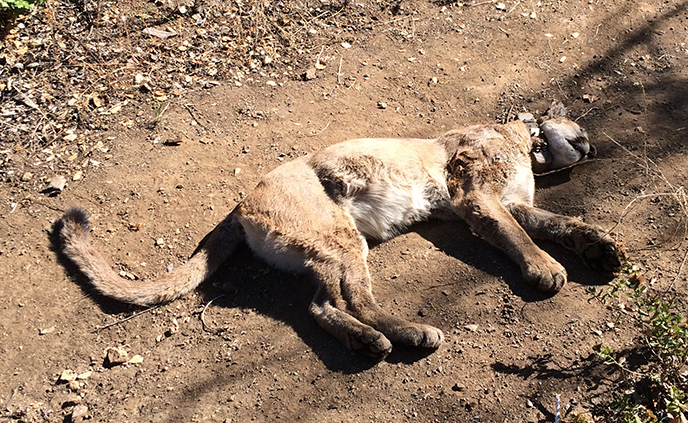|

National Park Service
Contact: Kate Kuykendall, 805-370-2343 THOUSAND OAKS, Calif. -- Three young mountain lions have been found dead in the Santa Monica Mountains in recent weeks, illustrating how difficult it can be for the large carnivores to survive into adulthood in such an urbanized and fragmented landscape."If you're a mountain lion in the Santa Monica Mountains, this is just not an easy place to grow up," said Dr. Seth Riley, wildlife ecologist for the National Park Service. "From our roads to rat poisons to potentially increased interactions with other mountains lions, it is very difficult for young animals to make it to adulthood, establish their own home range and reproduce."
P-34, a juvenile female researchers began following when she was only three weeks old, was found by a runner on a trail in Point Mugu State Park on September 30.
Based on the preliminary results of a necropsy, which showed significant amounts of free blood in her chest cavity and around her heart, it appears that she died as a result of rodenticide poisoning. Wounds on her face and body indicated she had been in a fight just before her death, likely with another lion, but they were superficial and were not the direct cause of death.
National Park Service research has documented widespread exposure to rodenticides, also known as rat poisons, among wildlife in and around the Santa Monica Mountains. Two other mountain lions and many coyotes have died directly as a result of poisoning, and exposure to the poisons has been associated with a severe disease epidemic in bobcats.
P-34 made headlines last December when she was discovered lounging under a trailer in a mobile home park in Newbury Park. Earlier that day a resident snapped a stunning photo of P-34 walking in her backyard. Her sibling, P-32, was struck and killed by a vehicle on Interstate 5 this August after making a remarkable journey out of the Santa Monica Mountains.
In a separate incident last month, National Park Service biologist Jeff Sikich found the remains of P-43 and a previously unknown sibling in a remote part of the eastern Santa Monica Mountains. The two kittens were only three months old. P-43 was marked by biologists at three or four weeks of age and biologists at the time thought she was the only kitten in the litter.
The young kittens had been consumed by another animal. Forensic DNA results from UCLA will potentially provide more information on the species of animal involved in the attack and may even identify the specific individual, if it was one of the study's collared mountain lions.
P-43's mother, P-23, has had two litters of kittens and both litters have now been killed by other animals. Gridlocked, the urban wildlife blog for Santa Monica Mountains National Recreation Area, has more details about these cases of infanticide.
Infanticide is a form of intra-specific conflict, which is the number one cause of death since the National Park Service began studying mountain lions in and around the Santa Monica Mountains in 2002. The purpose of the study is to determine how they survive in an increasingly urbanized environment.
Scientists are currently tracking 10 animals in the region (see attached map).
Santa Monica Mountains National Recreation Area (SMMNRA) is the largest urban national park in the country, encompassing more than 150,000 acres of mountains and coastline in Ventura and Los Angeles counties. A unit of the National Park Service, it comprises a seamless network of local, state and federal parks interwoven with private lands and communities. As one of only five Mediterranean ecosystems in the world, SMMNRA preserves the rich biological diversity of more than 450 animal species and 26 distinct plant communities. For more information, visit nps.gov/samo.
###
|
Last updated: October 9, 2015
